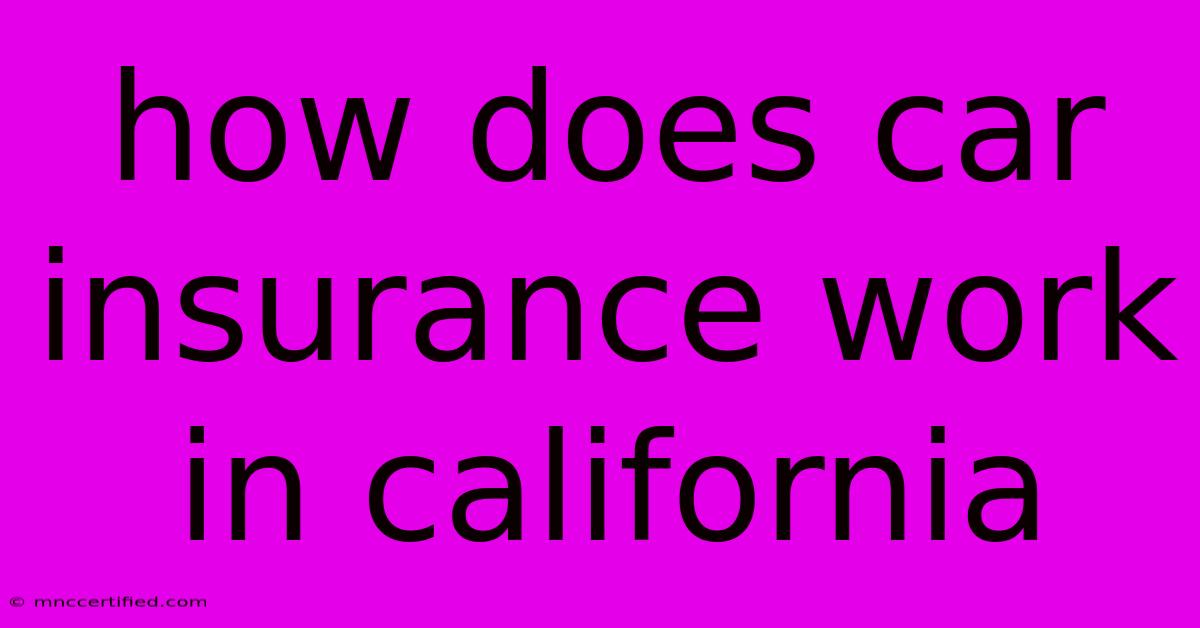How Does Car Insurance Work In California

Table of Contents
How Does Car Insurance Work in California? Navigating the Golden State's Road to Coverage
California, the land of sunshine and endless highways, also boasts a comprehensive car insurance system. Understanding how it works can save you money and ensure you're adequately protected on the road. This guide breaks down the basics of California car insurance, helping you navigate the system and find the right coverage for your needs.
Mandatory Coverage: The Essentials
In California, every driver is legally required to carry specific car insurance coverage. These are known as minimum financial responsibility requirements and include:
- Liability Coverage: This protects you financially if you cause an accident that results in injuries or damage to another person's property.
- Bodily Injury Liability: Covers medical expenses, lost wages, and pain and suffering for people injured in an accident you caused.
- Property Damage Liability: Pays for repairs or replacement of damaged property, including vehicles, in an accident you caused.
Note: Failure to carry these mandatory coverages can lead to hefty fines and even license suspension.
Beyond the Basics: Additional Coverage Options
While the minimum requirements provide essential protection, you can enhance your coverage with additional options, including:
- Collision Coverage: This pays for repairs or replacement of your own vehicle if you're involved in an accident, regardless of fault.
- Comprehensive Coverage: Covers damage to your vehicle from events like theft, vandalism, fire, and natural disasters.
- Uninsured/Underinsured Motorist Coverage (UM/UIM): Protects you if you're involved in an accident with a driver who doesn't have insurance or has insufficient coverage.
- Medical Payments Coverage (MedPay): Covers your medical expenses, regardless of who caused the accident.
- Rental Reimbursement: Pays for a rental car while your vehicle is being repaired after an accident.
Factors Affecting Your Premium: Know What Influences Your Costs
Your car insurance premium in California is calculated based on several factors. Understanding these factors can help you shop for the best rate:
- Driving Record: Your past driving history, including accidents, tickets, and DUI convictions, significantly impacts your premium.
- Vehicle: The make, model, year, and safety features of your car play a role in determining your insurance costs.
- Location: Where you live in California can influence your rates due to factors like traffic density and accident rates.
- Age and Gender: Younger and inexperienced drivers generally face higher premiums.
- Credit Score: Your credit score can be used to assess your risk profile, potentially affecting your rates.
- Coverage Levels: The amount of coverage you choose will directly influence your premium.
Finding the Right Coverage: Tips for Success
Navigating the California car insurance landscape can be complex. To find the right coverage at the best price:
- Compare Quotes: Don't settle for the first quote you receive. Get multiple quotes from different insurers to compare coverage and rates.
- Review Your Coverage Regularly: Your insurance needs can change over time. Re-evaluate your coverage periodically to ensure it still fits your situation.
- Consider Discounts: Many insurers offer discounts for good driving records, safety features, bundling policies, and other factors.
- Ask Questions: Don't hesitate to ask your insurance agent about specific coverage details, discounts, and how your premium is calculated.
Conclusion
Understanding the intricacies of California car insurance is crucial for responsible driving. By familiarizing yourself with the mandatory requirements, additional coverage options, and factors affecting your premiums, you can find the right policy to protect yourself and your finances on the road. Remember to shop around, compare quotes, and ask questions to ensure you're getting the best possible coverage at a fair price.

Thank you for visiting our website wich cover about How Does Car Insurance Work In California. We hope the information provided has been useful to you. Feel free to contact us if you have any questions or need further assistance. See you next time and dont miss to bookmark.
Featured Posts
-
George Gandy Insurance Carlsbad New Mexico
Nov 07, 2024
-
Liga Mx Club America Vs Pachuca Tv And Stream
Nov 07, 2024
-
Lurie Leads Early San Francisco Mayoral Results
Nov 07, 2024
-
David Lammy Under Fire For Donald Support
Nov 07, 2024
-
Watch Celtics Vs Warriors Tonight Game Time Tv Info
Nov 07, 2024